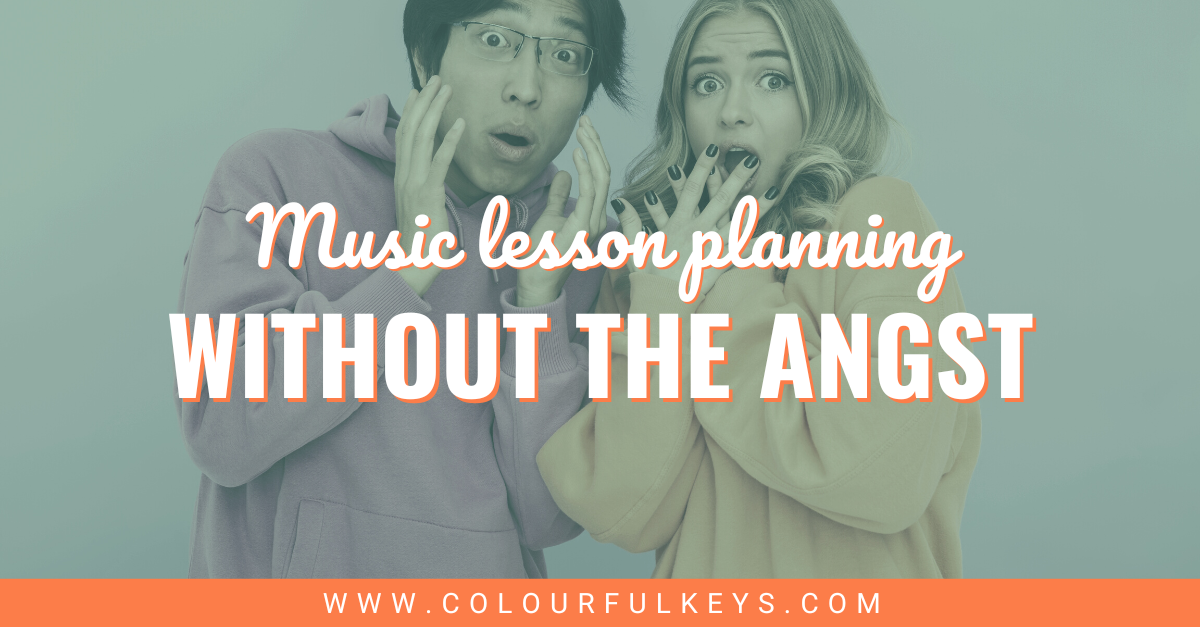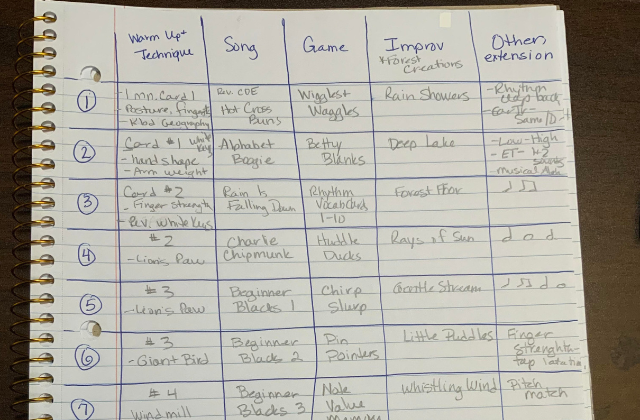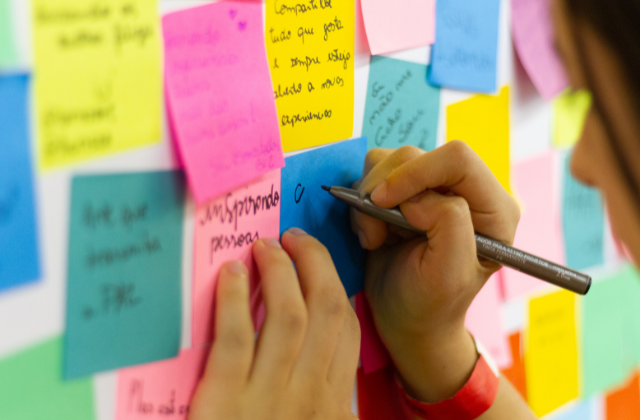
This article about taking perfectionism out of the music lesson planning process was written by Dana McCabe. Dana is a piano and voice teacher from Portland, Oregon, USA who teaches exclusively online. She earned a Bachelor’s Degree in Vocal Music Education and a Master’s Degree in Early Childhood Education, and spent twenty years teaching classroom music in elementary schools before opening her own studio. Dana sings with the ISing Choir where she is the alto section leader, assistant conductor and occasional substitute accompanist. She loves warm beach vacations, quiet time, a glass of wine and being an extreme night owl (especially all at once!).
Music lesson planning. The very thought can cause newbie teachers and seasoned educators alike to quake in their boots – particularly those with a more perfectionistic tendency.

I come from an educational background and taught in elementary schools for twenty years. As such, I’ve written hundreds of pages of lesson plans in my life.
I LOVE lesson planning! 🙌
When teaching school, I loved the organisation of it and the knowledge that when I showed up in the morning, I didn’t have to figure out what to do because I had a plan.
Now that I’m teaching private music lessons, I still love the lesson planning aspect – but it looks quite a bit different than when I had classes full of students.
Pathway to Imperfect Planning
In my drive to attain impeccable lesson plans, I’ve used extensive, personalised spreadsheets, handwritten music lesson planning books and even literally typed out an entire ten years’ worth of plans.
I did all that preparation with the intent to check things off as I taught them, and as each student mastered each skill.
Here’s why those endeavours haven’t been the greatest for me:
- Excessive daily and weekly time spent
- Unwieldy and hard to manage
- Too much printing
- Unnecessary double checking for a single teacher studio
At the end of the day, I just couldn’t keep up!
A Less-Than-Perfect Happy Place
Since that little journey to lesson-prep utopia didn’t work for me, I’ve experimented with several other strategies.
There have been periods where I didn’t make any plans at all. And times when I made an extensive agenda for each individual lesson.
I’ve even had seasons when I would just glance at the next page in the book to get an idea of what I needed for a student’s lesson.
After all that, I think I’ve finally honed in on a music-lesson-planning “happy place” that works well for me – even if it’s a bit imperfect.
My Perfectly-Imperfect Planning Process
Let’s first zoom out and view the grand scheme of my music lesson planning procedure before diving into the details.
Scope and Sequence
For me, preparing lessons is a way to make sure I’m covering all my bases. I do like to use method books, but I don’t feel like they’re as comprehensive as they could be.

I find the scope and sequence of any method book doesn’t work for me. They may progress too quickly or too slowly, or they introduce a concept too soon or too late. And sometimes I feel they’re missing something.
So I’ve come up with my own ideas of what I think my piano students should learn. Based on my research, reading and list-making, I came up with a document that has the bones of what I’m looking to accomplish as a teacher. Now I simply edit this blueprint as needed.
Levels of Learners
As my studio has grown, I have a variety of different levels to teach and I find that my piano music lesson planning process works best when I divide students into skill groups. From there, I can prepare for similar goals, games and activities, thus cutting back on planning time.
Beginners
Beginners are my absolute favourite to teach and plan for! I don’t put beginners in a method book until they’ve had at least six to ten weeks of “no book lessons”.
I once wrote out an entire ten weeks of plans for “no book lessons”. It was pages and pages, which I printed and bound together in a cohesive format. It was long and wordy, and I realised a list would work much better for me.
Now I have a sequenced list of games, techniques, rote songs and improvisations designed especially for beginners under the age of 9.
Older beginners tend to do the same kinds of things, but they usually only need 3 – 4 weeks to master the skills.
Here’s what the beginning of a typical “no book lesson” plan looks like for my young beginners:

After applying this “no book” format for a student, I can choose which method book will work best for them. That way I don’t waste money buying books that don’t fit.
Intermediates – Advanced
Many of the students in my studio have grown with me. Several of my intermediate students started out with me years ago, and I couldn’t be more proud of how they are progressing.
I have a few students who are out of method books (or nearly) so we’re investigating options for what they want to work on next. We explore classical, jazz, pop, chords, lead sheets, etc..
This makes me incredibly grateful for supplementary books.
Nitty Gritty
Now that you’ve seen the big picture, let’s get into the details of my piano music lesson planning prcoess.
The Tools
My little organising-teacher’s heart is happy to gather the materials and supplies needed to get my lesson plans ready for the year. This gear has granted me a path to well-designed lesson planning which takes a bit of initial effort with minimal upkeep:
- Binders: One for each day of the week with a tab for each student
- Sticky notes: A veritable rainbow of colours in all the sizes I can find
- Notebooks: 2 big notebooks for my handwritten lists
- Writing implements: Mechanical pencils, erasable coloured pencils, Sharpies, highlighters and favourite pens
The Timing
I do all my main lesson preparation for the year in August when I’m not teaching.
Throughout the year I make notes during lessons on how things are going, update each student’s learning goals and make lists of any music I need to order or print for a student.

My piano is home to a series of sticky notes where I jot things down such as “Music to Order”, “Music to Print”, “Student Suggestions”, “Achievements Reached”, etc.
As each 10 – 12 week term rolls around, I update my plans and look through the notes I have written, collecting what students will need for the next quarter.
Because I teach remotely, I put these items together in a packet that piano families can pick up from the studio. (Studio parents I see at choir practice get their materials hand-delivered.)
The Groups
Before diving into planning, I arrange my 32 students into planning sets of 2 – 5 students each. These groups tend to be made up of students who are at the same general level and using the same method book.
Students in the same batch will have individualised learning goals, but it’s helpful to be thinking about similar students at the same time.
Once I’ve grouped my students, I pull out the sections of my daily binders and get started.
During the process, I decide:
- Learning goals for the year
- Skills students are missing and/or need reinforcement in
- Method books to order
- Supplementary music for specific students
- Scale and/or chord challenges
- Sight reading
- What I like to call “et cetera”
Although I love and extensively use Google Docs and Spreadsheets, I actually write the majority of my planning out by hand. Hand-writing helps me remember things better and feel more organised.
If you teach buddy lessons, the lesson logistics cheatsheet from Vibrant Music Teaching will take all the mystery out of planning. Enter your info below and Nicola will send a free copy your way!

Subscribe to updates and get the Buddy Lesson Logisitics Cheatsheet
Enter your details to subscribe to the newsletter for piano teachers with information, tips and offers.
I hate spam as much as you do! I’ll only send you information that’s directly relevant to music teachers and you can unsubscribe at any time.
VMT members can download this planner from the Printable Library. Never heard of the membership? Still on the fence? Take a tour today to see what you’re missing!
The Magic of Review
“Star Songs” are what I like to call students’ pieces to review. (Yes, I know they’re really “pieces” and not “songs”, but “Star Pieces” just doesn’t sound as fun to me!)
Revisiting pieces gives students a chance to choose a piece they liked from earlier in the year, and to work it back up to performance level. I keep track of their “Star Songs” in my binder, and students keep track by drawing a star near the title of the piece they have successfully played.
This review helps students think artistically about dynamics, articulation, pedalling, tempo, repeats, etc.. I’ve also noticed that several students are naturally bringing these expressive bits into their regular lesson pieces.
The Plan in Action
The example below is a real plan for one of my late-intermediate students. She is an accomplished player who doesn’t really like classical or pop music – video game music is her jam. 🎮

The notes are colour-coded in this way:
- Turquoise: current core-learning books
- Dark blue: supplemental books
- Green: sheet music
- Pink: completed books
- Smaller-sized blue: personal information
You can see her “Star Songs” list as well as the blue note listing the materials I provided for her for spring term. The pink note is her learning list for the year.

Do you have a unique method you use for lesson planning?
After trying so many different ways to approach music lesson planning, this perfectly-imperfect way works wonders for me. Let me know what works best for you in the comments below.
For more help with music lesson planning, check out Nicola’s centralised hub page for all-things-lesson-planning.